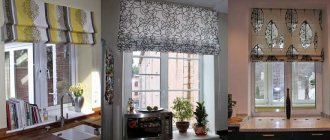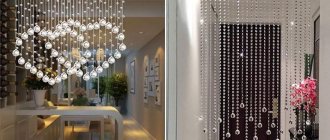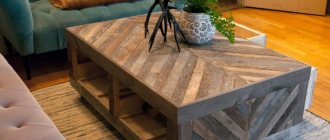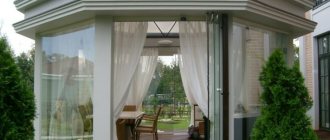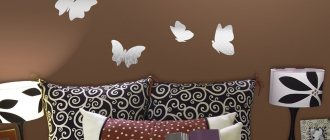Roman blinds in the living room interior are in demand by customers due to their functionality and simplicity. External laconicism combined with ease of use allows them to fit into any style room, emphasizing the tastes and individual preferences of the owners. The discreet nature of the canvas allows it to be combined with any decorations and other types of curtains, opening up space for design solutions.
Roman blinds and their features
This type of curtain is made from an even cut of fabric secured to several transverse strips. Thanks to them, when the curtains are raised, the textiles gather into even folds, reminiscent of a cascade. Most products are equipped with a special mechanism that regulates the level of light in the room.
Features of Roman blinds:
- strictly rectangular shape of the canvas;
- uniform arrangement of pockets with fixed strips along the entire length of the curtains;
- manufacturing guides from soft or hard materials (the severity of the folds depends on their rigidity);
- a strip of plastic or metal attached to the bottom edge of the product (provides uniform tension of the fabric).
Thanks to their simple and convenient design, curtains of this type are used in such modern design trends as high-tech, minimalism, and modern. In classical styles, pure Romanesque curtains are rare: more often they are part of the composition in combination with tulle, lambrequin and classic straight-cut curtains.
Features of curtains
Modern Roman blinds seem too simple. However, thanks to many advantages, these models are hung on windows in kitchens and bathrooms, in living rooms and on balconies:
- products are fixed on the wall above the opening, on the ceiling and on the window frame or above the frame inside the opening. Even if the internal opening is not deep enough, the curtain will not interfere with placing flower pots on the windowsill;
- adjusting the level of raising/lowering the canvas. This is especially convenient if the curtain falls below the window sill. To water the flowers and wipe the window sill, you do not need to lift the canvas completely. Textile strips fixed at different levels create soft lighting in the room. At the same time, natural light is not greatly reduced, but furniture and furnishings are protected from direct sunlight. Multi-level textiles will elegantly decorate a window consisting of several sashes (this applies to bay windows);
Roman blinds occupy the top lines of the decor rating
- easy care - the design of the curtains eliminates the strong accumulation of dust. Fabric sheets can be quickly removed from the curtain rod for washing;
- It’s convenient to change window decor at different times of the year. In summer, it is advisable to hang transparent and translucent materials on the windows. And for the winter, canvases are sewn from denser fabrics;
- a variety of textile fabrics makes it easy to choose curtains for interiors of different styles;
- safety - curtain designs use special weighting strips that are fixed at the bottom of the curtains. These strips prevent strong vibrations of textiles in drafts, which is important when installing thin kitchen curtains next to gas stoves.
Products are mounted on the wall above the opening
The high prices of some models equipped with electric control mechanisms can be considered a slight disadvantage of the designs.
Advantages and disadvantages
Advantages of Roman curtains:
- located close to the window, saving space;
- Conveniently adjustable using a built-in curtain rod;
- well protected from sunlight;
- simple in design, go well with any other types of curtains and accessories;
- unpretentious in care, almost do not accumulate dirt and dust;
- have a laconic shape, used to decorate windows of non-standard shape (arched, bay, attic, beveled, triple);
- Available in different colors and styles, so they are suitable for any room.
The disadvantages of curtains include the fact that they completely cover the window opening. This makes using the window difficult: to open it, the textile decor will need to be lifted completely.
Criterias of choice
Good curtains should:
- protect the room from the sun;
- create comfort and harmonize with furniture and wall decor;
- combine with other textiles;
- complement the style without overloading it;
- be user friendly.
The choice of material for curtains depends on the lighting in the bedroom. If the windows face south and the sun does not leave the room, it is better to opt for impermeable fabric (blackout). For the north side, transparent or translucent fabrics (organza and tulle) are suitable.
When choosing the design of Roman curtains, take into account the density of the folds and the possibility of additional shading with other types of curtains.
Photos of fabrics and window and door openings decorated with them can be seen online, on the websites of designers and stores.
Varieties and choice of fabric
Roman products are divided into several types, differing in design features.
Main types:
- Classic. They are a canvas on a frame: when raised, it gathers into folds, and when lowered, it looks straight and even.
- Frameless. They are distinguished by the fact that they do not have rigid ribs and rise only from the side parts of the product: the lower part sags, forming an arc with folds.
- Cascade. They are distinguished by a special arrangement of slats on top of each other, due to which the curtains, when lowered, look like a lush cascade.
- Double layer. They consist of 2 canvases located one above the other: light and translucent (for darkening the window during the day) and denser (for reliable protection from sunlight during sleep and rest).
- Automatic. Instead of the classic lifting structure, they have an electric drive controlled by a remote control.
Curtains are made from any type of fabric: from textured satin to translucent veil.
Common textile options:
- Natural fabrics: cotton, linen. They are environmentally friendly and safe for health, but are difficult to care for, wrinkle easily and are quite expensive.
- Synthetic materials such as polyester. They are durable, resistant to damage, but have poor air permeability, accumulate static electricity and cannot withstand high temperatures.
- Mixed fabrics: jacquard, organza, velvet, artificial silk. The most popular because they combine the advantages of synthetic and natural types of textiles.
- Translucent materials: tulle, veil, mesh. They let sunlight through, giving the interior lightness and visually expanding the space.
- Bamboo fabric. It is easy to care for and fits into styles with an emphasis on naturalness (eco, country, Scandinavian).
- Blackout. Prevents sunlight from entering the hall.
- Textured fabrics: velvet, silk, satin. They add elegance to the interior, but are expensive and easily collect dust and dirt.
Less commonly, curtains are made from unusual materials: wool, burlap, woven fabric. This type of window decoration adds originality and originality to the interior.
Materials
A variety of styles, sizes and colors allows you to create a bedroom interior to suit every taste. Curtains look great both in plain colors and with intricate patterns. These can be ordinary fabrics, or impregnated with special compounds to prevent fading. Fabric with complex weaving will look advantageous.
Popular materials for sewing Roman blinds for the bedroom:
- coarse cotton (linen, burlap),
- taffeta,
- heavy wool
- organza,
- muslin,
- wooden or bamboo bases.
The density of fabric in the bedroom is an important parameter. Light translucent or transparent ones are appropriate if the curtain serves as tulle as in the photo.
Opaque and light-proof fabrics successfully act as blackout curtains. Black-out fabrics are chosen for them.
Determining the light transmittance of a fabric is very simple. You need to look through the fabric at the window.
This is exactly how much light the curtain will let through.
Roman curtains in the living room interior
Curtains of this type are distinguished by their simplicity and laconic design, so they are rarely used to create a bright accent on the window.
Decorating a window opening with simple, monochromatic products will emphasize the severity of the forms and the clarity of the lines. The emphasis on convenience and functionality fits into the ideas of these directions.
In spacious living rooms with high windows, cascading or frameless curtains are used. They look less strict than classic ones, so they are suitable for lighter interiors in country, ethnic, and eclectic styles.
The simplicity of Roman curtains will help to highlight the size and shape of the window. This is convenient when it comes to rooms with a lot of furniture, decorations and interior items.
In a living room designed in a luxurious style, where the emphasis is on rich decoration (Baroque, Empire, classic), this type of decor is used as part of the window composition. It is combined with lambrequins, elaborate cornices, tulle and curtains made of satin, silk, and velvet.
The simplicity of the curtains allows them to fit into the design of almost any window: they will protect from light without violating the design intent.
In small living rooms, preference is given to Romanesque curtains made of light, translucent materials. Straight cut in combination with light shades and translucent textiles visually expand the space and eliminate the feeling of oppressive walls. The effect will be complemented by a horizontal pattern on the canvas.
Roman blinds for a large living room should be heavy and made of textured fabrics. They will help emphasize the spaciousness and luxury of the room.
How to choose Roman blinds for plastic windows
Roman blinds in the living room
Roman blinds for double-glazed windows require special preparation before installation. A plastic window cannot be drilled to secure the cornice. Damage to the seal of the glass unit will not be restored in the future. The cornice should be fixed above the opening on the wall. If necessary, hanging or stick-on modifications can be used.
Types of Roman blinds for plastic windows also include types with intra-window placement. They come with special curtain rods with adhesive tape that can be attached to the frame.
For plastic windows with opening sashes, there are fasteners that allow you to fix the same plastic brackets without drilling. The included curtain rod is inserted into them.
It must be remembered that the fabric cannot be placed close to the window, as this will interfere with the ventilation of the room.
Mounting methods
Classic and cascading Roman curtains have a built-in curtain rod that is used to attach them to the window.
The main ways of its location:
- On the window sash. Curtains attached in this way provide good protection from sunlight and do not interfere with additional curtains, drapes or tulle on the cornice.
- On the frame. The decor fits almost flush against the window, saving space and leaving the window sill free.
- On the wall. Attaching curtains slightly to the side of the window opening visually widens it, which is useful in rooms with small windows.
- To the ceiling. Suitable for large, high rooms, it looks unusual and stylish.
Frameless Roman curtains without a built-in cornice are secured using rings or loops. They use ties, braids, belts, and eyelets less often: they look original and distinctive.
What materials are used to make Roman blinds?
Elegant Roman blinds can look different depending on the color, texture and pattern of the fabric from which they are made. For the hall, choose curtains made of thick jacquard, satin, muslin with or without a pattern. The fabric does not allow sunlight to pass through and protects well from prying eyes, and besides, it looks solemn even in a monochromatic design.
Thick plain curtains.
For a library or work area, translucent lightweight fabrics are selected that cover the window from prying eyes and let in light. For example, linen or organza.
Translucent linen curtains.
For the nursery and bedroom, it is important that the curtains do not allow light to pass through during rest or sleep. Therefore, for these rooms it is better to choose dense synthetic fabrics with minimal light transmission.
Thick Roman blinds in the bedroom.
The degree of light transmission of various types of fabric:
| Fabrics that do not transmit light. | Vinyl, satin, blackout, canvas, jacquard, curtain fabric. | Transmits from 0 to 10% of light. |
| Translucent fabrics. | Linen, cotton, crepe satin, acrylic, acetate, muslin. | Transmits from 25 to 40% of light. |
| Transparent fabrics. | Veil, lace, organza. | Transmits from 50 to 90% of light. |
Cotton fabric
Cotton is a natural material that transmits light well, but wrinkles easily. It is rarely used in its pure form, most often with the addition of synthetic fibers that improve the properties of cotton.
+ Advantages of cotton fabric
- naturalness;
- inexpensive cost;
- bright colors;
- softness.
— Disadvantages of cotton fabric
- wrinkles a lot;
- shrinks after washing;
- fades in the sun.
Cotton Roman blinds.
Linen fabric
Linen Roman blinds in the interior are used undyed, in their natural light gray shade. Linen fabric is a noble natural material that is smooth to the touch.
+ Benefits of linen fabric
- naturalness;
- high wear resistance;
- does not shrink or fade after washing;
- does not wrinkle.
— Disadvantages of linen fabric
- wrinkles a lot;
- does not have dimensional stability.
Linen curtains are happily used in ethnic, Mediterranean, and rustic interiors in their natural form.
Linen in the living room.
Synthetic fabrics
Synthetic fabrics are often used for sewing curtains.
+ Advantages of synthetic fabrics
- do not wrinkle;
- differ in different textures and colors;
- have different light transmittance from 0% to 90%;
- have dust-repellent properties;
- do not require frequent care.
— Disadvantages of synthetic fabrics
- some fabrics become deformed when exposed to heat or are easily flammable;
- When burning, they can release harmful substances.
Frameless synthetic curtain with a rigid lambrequin.
Blended fabrics
Fabric woven from a mixture of natural and synthetic fibers is called blended. Such fabrics are very practical, have a wide range of names, and have varying degrees of light transmission.
+ Advantages of mixed fabrics
- natural fabrics wrinkle less;
- do not shrink.
— Disadvantages of mixed fabrics
- electrified;
- pellets are formed.
Colors and designs
The choice of shade and pattern of curtains depends on the design of the room. The canvas is produced in a variety of colors, so there will be no problems finding curtains to match your interior.
Nuances of choosing tone and pattern:
- If the living room is decorated in discreet colors (gray, beige, cream, peach), it will be well complemented by bright, colored curtains. The contrast looks especially beneficial if the shade of the textile is combined with other accessories in the room.
- Roman photo curtains are well suited to modern and themed interiors. Wallpaper with photographs of the sky, nature, and the city at night look especially impressive on panoramic windows, while drawings of animals, plants, and marine life decorate small openings.
- Matching the shade of curtains to the carpets, pillows, and upholstery will help you fit the curtains into the living room. Identical prints and patterns will add uniformity to the interior and eliminate chaos.
- A combination of similar tones of the same color (light green and lime, violet and lilac) looks beneficial. This design of the window opening guarantees simplicity and lightness.
- Curtains with vertical stripes visually increase the height of the ceiling, and curtains with horizontal stripes expand the window. These features are used to eliminate crowding in small rooms.
- Floral ornaments add freshness and vigor to the interior. They will suit a living room in a country or Provence style.
- Damask, or monogram, pattern on the canvas will emphasize the pretentiousness and luxury of the interior. Curtains for windows with similar patterns are appropriate in styles such as Baroque and Empire.
- Curtains with embroidery create a feeling of coziness. They go well with light shades and help create homely comfort in the living room.
- Unusual geometric prints suit modern styles. They give the interior expressiveness and expressiveness.
- The edging of the curtains visually expands the window and emphasizes its shape. It looks especially impressive on canvas with a figured bottom and edges.
If Roman products will hang together with tulle, you should take care of the compatibility of shades in all elements of the composition.
Decorative elements and design
The use of decorative elements will help to add charm to strict, straight Roman curtains.
Decoration options:
- curtain tape - will create a beautiful drapery in addition to the folds;
- tassels - add playfulness, suitable for oriental style;
- fringe, ruffles - will emphasize the unusual shape of the folds and add elegance;
- bows - will add lightness and romance;
- inserts and pendants made of wood, glass beads, metal - will add unusualness and emphasize belonging to a particular interior style.
Decorations attached to the fabric should not interfere with the free raising and lowering of curtains.
Fastening
Roman blinds are an excellent replacement for regular curtains. And they are easily installed where ordinary curtains cannot be hung - on a window, ceiling, in any opening or part of an opening.
When installing, pay attention to the opening of the window. There should be a flow of fresh air in the bedroom.
Accordingly, curtains should not interfere with their opening. Thanks to the weighting rail, they do not sag and do not flutter due to drafts.
The kit always includes a mechanism that lifts the fabric up. For the bedroom, the most convenient control option is automatic (using a remote control).
It is easy to raise and lower to the desired level and adjust the lighting of the room.
Textiles in the bedroom require special care. It should be cleaned more often. Roman blinds are the easiest to keep in order. It is enough to vacuum, straightening the folds.
Combination with other curtains
The combination of Roman blinds with other types of curtains helps create a feeling of completeness in the design.
Popular combinations:
- with tulle - gives a light, sunny look;
- with curtains - visually expands the window, used in modern styles to emphasize simplicity and functionality;
- with lambrequins - helps to dilute the severity of Roman blinds, giving the window a decorative finish;
- with curtains - thanks to the harmonious and simple combination, it is suitable for classic styles.
The combination of Roman curtains with French and English curtains looks original. When using heavy fabrics, this combination adds elegance and luxury to the interior. Light, translucent textiles on top of straight Roman curtains create an atmosphere of lightness and carefreeness.
Without slats
Departing from traditional classic examples, most manufacturers offer models of Roman blinds without frames. This is a standard piece of dense fabric that gathers into beautiful folds without the “help” of inserts.
Tips and tricks for choosing
When choosing Roman blinds, you should pay attention to the quality of not only the fabric, but also the materials for the rods. The planks should be dense, hard, inflexible, preferably made of wood or metal. Products made from brittle, easily bendable materials quickly break under the weight of the fabric, so it is better to discard them.
Textiles for curtains should be easy to clean. Products made from natural expensive fabrics (silk, velvet) quickly collect dirt, wrinkle from washing and take a long time to dry. Because of these features, it is better to choose curtains treated with protective compounds.
If the window faces the sunny side, it is advisable to buy fabrics that are resistant to fading and fading.
For convenience and safety, it is advisable to take weighted products with weights on the bottom. The latter prevent the canvas from moving freely, thereby preventing contact with water and detergents, and reducing the likelihood of fire.
When choosing the appearance of curtains, you should focus on the overall design of the room. Photos with various ways of using Roman curtains in the interior will help you choose the optimal design solution.
How to make Roman blinds with your own hands
To make Roman blinds with your own hands, you will need old blinds or wooden beams. Below we will provide photo instructions for both of these methods, but the process always begins the same way - with preparing the fabric.
- Measure the window (or old blinds) and cut a piece of fabric that will be the width and length of the window + 1 cm on each edge for seams. For example, if the window width is 60 cm, then you should cut 62 cm of fabric.
- Depending on the density of the fabric you choose, determine whether you need additional lining or not.
- Fold 1 cm from each edge, iron the fabric, and then sew on a sewing machine.
4. Remove excess slats from old blinds. We glue the remaining ones to the fabric from the wrong side, as shown in the pictures.
5. When using wooden beams, you will need to additionally sew rings into which the cord will be threaded. You can glue or sew in the wooden planks themselves, at your discretion.
6. At the top we glue or use a stapler to install a thick wooden block with 2-3 hooks pointing down.
